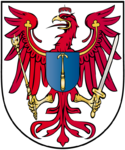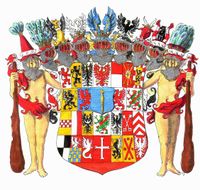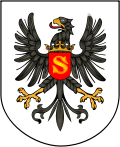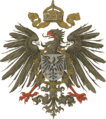House of Hohenzollern
.png) |
|
| Country | Germany, Romania |
|---|---|
| Ancestral house | Burchardinger dynasty |
| Titles | Count of Zollern Margrave of Brandenburg Duke of Prussia Burgrave of Nuremberg Margrave of Bayreuth Margrave of Brandenburg-Ansbach King of Prussia German Emperor Prince of Neuchâtel King of Romania |
| Founder | Burgrave Frederick I of Nuremberg |
| Final sovereign |
Germany and Prussia: |
| Current head |
Germany and Prussia: HM King Michael (1947–) |
| Founding | 1100s AD |
| Deposition | Germany and Prussia: 1918: German Revolution Romania: 1947: Stalinist take-over |
| Ethnicity | German, Romanian |
| Cadet branches | Hohenzollern-Hechingen Hohenzollern-Sigmaringen Hohenzollern-Haigerloch |
The House of Hohenzollern is a noble family and royal dynasty of electors, kings and emperors of Prussia, Germany and Romania. It originated in the area around the town of Hechingen in Swabia during the 11th century. They took their name from their ancestral home, the Burg Hohenzollern castle near Hechingen.
The family uses the motto Nihil Sine Deo (English: Nothing Without God). The family coat of arms, first adopted in 1192, began as a simple shield quarterly sable and argent. A century later, in 1317, Frederick IV, Burgrave of Nuremberg, added the head and shoulders of a hound as a crest.[1] Later quartering reflected heiresses’ marriages into the family.
The family split into two branches, the Catholic Swabian branch and the Protestant Franconian branch. The Swabian branch ruled the area of Hechingen until their eventual extinction in 1869. The Franconian branch was more successful: members of the Franconian branch became Margrave of Brandenburg in 1415 and Duke of Prussia in 1525. Following the union of these two Franconian lines in 1618, the Kingdom of Prussia was created in 1701, and subsequently led the unification of Germany and the creation of the German Empire in 1871.
Social unrest at the end of World War I led to the German Revolution of 1918, with the formation of the Weimar Republic forcing the Hohenzollerns to abdicate, thus bringing an end to the modern German monarchy. The Treaty of Versailles in 1919 set the final terms for the dismantling of the German Empire.
Origins
Counts of Zollern (before 1061-1204)


The oldest known mention of the Zollern was in 1061. It was a county, ruled by the counts of Zollern, who are believed to have originated from the Burchardinger dynasty.
- until 1061: Burkhard I
- before 1125: Frederick I
- circa 1142 : Frederick II
- before 1171 – circa 1200: Frederick III/I (son of, also Burgrave of Nuremberg)
Count Frederick III of Zollern was a loyal retainer of the Holy Roman Emperors Frederick Barbarossa and Henry VI, and around 1185 he married Sophia of Raabs, the daughter of Conrad II, Burgrave of Nuremberg.
After the death of Conrad II, who left no male heirs, Frederick III was granted the burgraviate of Nuremberg in 1192 as Burgrave Frederick I of Nuremberg-Zollern. Since then the family name has been Hohenzollern.
After Frederick's death, his sons partitioned the family lands between themselves:
- The older brother[2], Frederick IV, received the county of Zollern and burgraviate of Nuremberg in 1200 from his father, thereby founding the Swabian branch of the House of Hohenzollerns. The Swabian line remained Catholic.
- The younger brother[2], Conrad III, received the burgraviate of Nuremberg from his older brother Frederick IV in 1218, thereby founding the Franconian branch of the House of Hohenzollern. The Franconian line later converted to Protestantism.
Franconian cadet branch and Brandenburg-Prussian Branch
The cadet Franconian branch of the House of Hohenzollern was founded by Conrad III, Burgrave of Nuremberg.
Beginning in the 16th century, this branch of the family became Protestant and decided on expansion through marriage and the purchase of surrounding lands.
The family supported the Hohenstaufen and Habsburg rulers of the Holy Roman Empire during the 12th to 15th centuries, and they were rewarded with several territorial grants.
In the first phase, the family gradually added to their lands, at first with many small acquisitions in the Franconian and Bavarian regions of Germany:
- Ansbach in 1331
- Kulmbach in 1340
In the second phase, the family expanded their lands further with large acquisitions in the Brandenburg and Prussian regions of Germany and Poland:
- Margraviate of Brandenburg in 1417
- Duchy of Prussia in 1618
These acquisitions eventually transformed the Hohenzollerns from a minor German princely family into one of the most important in Europe.
Burgraves of Nuremberg (1192–1427)
.svg.png)
- 1192–1200/1204: Frederick I/III (also count of Zollern)
- 1204–1218: Frederick II/IV (son of, also count of Zollern)
- 1218–1261/1262: Conrad I/III (brother of, also count of Zollern)
- 1262–1297: Frederick III (son of)
- 1297–1300: John I (son of)
- 1300–1332: Frederick IV (brother of)
- 1332–1357: John II (son of)
- 1357–1398: Frederick V (son of)
At Frederick V's death on 21 January 1398 his lands were partitioned between his two sons:
- 1398–1420: John III/I (son of, also Margrave of Brandenburg-Kulmbach)
- 1420–1427: Frederick VI/I/I, (brother of, also Elector of Brandenburg and Margrave of Brandenburg-Ansbach)
After John III/I's death on [11 June 1420, the two principalities were briefly reunited under Frederick VI/I/I. From 1412 Frederick VI became Margrave of Brandenburg as Frederick I and Elector of Brandenburg as Frederick I. From 1420 he became Margrave of Brandenburg-Kulmbach. Upon his death on 21 September 1440, his territories were divided between his sons:
- John II, Margrave of Brandenburg-Kulmbach
- Frederick II, Elector of Brandenburg
- Albert III, Elector of Brandenburg and Margrave of Brandenburg-Ansbach
From 1427 onwards the title of Burgrave of Nuremberg was absorbed into the titles of Margrave of Brandenburg-Ansbach and Margrave of Brandenburg-Kulmbach.
Margraves of Brandenburg-Ansbach (1398–1791)

- 1398: Frederick I (also Margrave of Brandenburg-Kulmbach)
- 1440: Albert I/I/III Achilles (son of, also Margrave of Brandenburg-Kulmbach and Elector of Brandenburg)
- 1486: Frederick II/II (son of, also Margrave of Brandenburg-Kulmbach)
- 1515: George I/I the Pious (son of, also Duke of Brandenburg-Jägerndorf)
- 1543: George Frederick I/I/I/I (son of, also Margrave of Brandenburg-Kulmbach, Duke of Brandenburg-Jägerndorf and Regent of Prussia)
- 1603: Joachim Ernst
- 1625: Frederick III
- 1634: Albert II
- 1667: John Frederick
- 1686: Christian I Albrecht
- 1692: George Frederick II/II (later Margrave of Brandenburg-Kulmbach)
- 1703: William Frederick (before 1686–1723)
- 1723: Charles William (1712–1757)
- 1757: Christian II Frederick (1757–1791) (son of, also Margrave of Brandenburg-Kulmbach)
On 2 December 1791, Christian II Frederick sold the sovereignty of his principalities to king Frederick William II of Prussia.
Margraves of Brandenburg-Kulmbach (1398-1604), later Brandenburg-Bayreuth (1604–1791)


- 1397: John I
- 1420: Frederick I (also Margrave of Brandenburg-Ansbach)
- 1440: John II
- 1457: Albert I/I/III Achilles (also Margrave of Brandenburg-Ansbach and Elector of Brandenburg)
- 1486: Siegmund
- 1495: Frederick II/II (also Margrave of Brandenburg-Ansbach)
- 1515: Casimir
- 1527: Albert II Alcibiades
- 1553: George Frederick I/I/I/I (also Margrave of Brandenburg-Ansbach, Duke of Brandenburg-Jägerndorf and Regent of Prussia)
- 1603: Christian I
- 1655: Christian II Ernst
- 1712: George I William
- 1726: George Frederick II/II (previously Margrave of Kulmbach)
- 1735: Frederick IV
- 1763: Frederick V Christian
- 1769: Christian II Frederick (until 1791, also Margrave of brandenburg-Ansbach)
On 2 December 1791, Christian II Frederick sold the sovereignty of his principalities to king Frederick William II of Prussia.
Margraves and Electors of Brandenburg (1417–1806)



- 1415–1440: Frederick I/I/VI (also Margrave of Brandenburg-Kulmbach and Burgrave of Nuremberg)
- 1440–1470: Frederick II (son)
- 1470–1486: Albrecht III/I/I Achilles (brother) (also Margrave of Brandenburg-Kulmbach and Margrave of Brandenburg-Ansbach)
- 1486–1499: John I Cicero (son)
- 1499–1535: Joachim I Nestor (son)
- 1535–1571: Joachim II Hector (son)
- 1571–1598: John II George (son)
- 1598–1608: Joachim III/I/I Frederick (son, also Duke of Brandenburg-Jägerndorf and Regent of Prussia)
- 1608–1619: John III/I Sigismund (son, also duke of Prussia)
- 1619–1640: George William I/I (son, also duke of Prussia)
- 1640–1688: Frederick III/I William the Great (son, also duke of Prussia)
- 1688–1701: Frederick IV/II/I (son, also Duke of Prussia and King in Prussia)
From 1701 the title of Elector of Brandenburg was attached to the title of King in and of Prussia.
Dukes of Brandenburg-Jägerndorf (1523–1622)

The Duchy of Brandenburg-Jägerndorf was purchased in 1523.
- 1541–1543 : George I/I the Pious (also Margrave of Brandenburg-Ansbach)
- 1543–1603 : George Frederick I/I/I/I (also Margrave of Brandenburg-Ansbach, Margrave of Brandenburg-Kulmbach and Regent of Prussia)
- 1603–1606 : Joachim I/I/III (also Regent of Prussia and Elector of Brandenburg)
- 1606–1621 : Johann Georg of Hohenzollern
The duchy of Brandenburg-Jägerndorf was confiscated by Ferdinand III of the Holy Roman Empire in 1622.
Margraves of Brandenburg-Küstrin (1535–1571)

The short-lived Margraviate of Brandenburg-Küstrin was set up, against the Hohenzollern house laws on succession, as a secundogenitur fief of the House of Hohenzollern, a typical German institution.
- 1535–1571: Johan the Wise, Margrave of Brandenburg-Küstrin (son of Joachim I Nestor, Elector of Brandenburg)
He died without issue. The Margraviate of Brandenburg-Küstrin was absorbed in 1571 into the Margraviate and Electorate of Brandenburg.
Margraves of Brandenburg-Schwedt (1688–1788)

From 1688 onwards the Margraves of Brandenburg-Schwedt were a side branch of the House of Hohenzollern. The Margraviate of Brandenburg-Schwedt although never was a principality with allodial rights in its own right.
- 1688–1711 : Philip William, Prince in Prussia, Margrave of Brandenburg-Schwedt (son of Frederick William, Elector of Brandenburg)
- 1731–1771 : Frederick William, Prince in Prussia, Margrave of Brandenburg-Schwedt (son of)
- 1771–1788 : Henry Frederick, Prince in Prussia, Margrave of Brandenburg Schwedt (son of)
In 1788 the title was incorporated into the Kingdom of Prussia.
Dukes of Prussia (1525–1701)

In 1525 the Duchy of Prussia was established as a fief of the King of Poland.

- 1525–1568: Albert I
- 1568–1618: Albert II Frederick co-inheritor (son of)
- 1568–1571: Joachim I/II Hector co-inheritor (also Elector of Brandenburg)
- 1578–1603: George Frederick I/I/I/I (Regent, also Margrave of Brandenburg-Ansbach, Margrave of Brandenburg-Kulmbach and Duke of Brandenburg-Jägerndorf)
- 1603–1608: Joachim I/I/III Frederick (Regent, also Duke of Brandenburg-Jägerndorf and Elector of Brandenburg)
- 1608–1618: John I/III Sigismund (Regent, also Elector of Brandenburg)
- 1618–1619: John I/III Sigismund (Regent, also Elector of Brandenburg)
- 1619–1640: George William I/I (son of, also Elector of Brandenburg)
- 1640–1688: Frederick I/III William the Great Elector (son of, also Elector of Brandenburg)
- 1688–1701: Frederick II/IV/I (also Elector of Brandenburg and King in Prussia)
From 1701 the title of Duke of Prussia was attached to the title of King in and of Prussia.
Kings in Prussia (1701–1772)

In 1701 the title of King in Prussia was granted, without the Duchy of Prussia being elevated to a Kingdom within the Holy Roman Empire. From 1701 onwards the titles of Duke of Prussia and Elector of Brandenburg were always attached to the title of King in Prussia.
- 1701–1713: Frederick I/II/IV (also Duke of Prussia and Elector of Brandenburg)
- 1713–1740: Frederick William I (son of)
- 1740–1786: Frederick II the Great (son of, later also King of Prussia)
In 1772 the Duchy of Prussia was elevated to a kingdom.
Kings of Prussia (1772–1918)


In 1772 the title of King of Prussia was granted with the establishment of the Kingdom of Prussia. From 1772 onwards the titles of Duke of Prussia and Elector of Brandenburg were always attached to the title of King of Prussia.
- Frederick II the Great (1740–1786) (son of, before King in Prussia)
- Frederick William II (1786–1797) (nephew of)
- Frederick William III (1797–1840) (son of)
- Frederick William IV (1840–1861) (son of)
- Wilhelm I (1861–1888) (brother of)
- Frederick III (1888) (son of)
- Wilhelm II (1888–1918) (son of)
In 1871 the Kingdom of Prussia was a constituting member of the German Empire.
German Kings and Emperors (1871–1918)


Reigning (1871–1918)
In 1871 the German empire was proclaimed. With the accession of Wilhelm I to the newly-established imperial German throne, the titles of King of Prussia, Duke of Prussia and Elector of Brandenburg were always attached to the title of German Emperor.
- 1871–1888: William I (also King of Prussia)
- 1888: Frederick III (son of, also King of Prussia)
- 1888–1918: William II (grandson of, also King of Prussia)
In 1918 the German empire was abolished and replaced by the Weimar Republic.
Pretenders (1918 up to today)

Despite the abolition of the German monarchy in 1918, the House of Hohenzollern never relinquished their claims to the thrones of Prussia and the German Empire. These claims are linked by the Constitution of the second German Empire: according to this, whoever was King of Prussia was also German Emperor. However, these claims are not recognised by the Federal Republic of Germany.
| Name | Titular Reign |
Comments |
| Wilhelm II | 1918-1941 | Exiled in the Netherlands until his death |
| Crown Prince William | 1941-1951 | |
| Prince Louis Ferdinand | 1951-1994 | |
| Prince Georg Friedrich | since 1994 | |
| Prince Christian-Sigismund of Prussia | heir presumptive |
The head of the house is the titular King of Prussia and German Emperor. He also bears a historical claim to the title of prince of Orange. Members of this line style themselves princes of Prussia.
Swabian senior branch

The senior Swabian[2] branch of the House of Hohenzollern was founded by Frederick II, Burgrave of Nuremberg.
Ruling the minor German principalities of Hechingen, Sigmaringen and Haigerloch, this branch of the family decided to remain Roman Catholic and from 1567 onwards split into the Hohenzollern-Hechingen, Hohenzollern-Sigmaringen and Hohenzollern-Haigerloch branches. When the last count of Hohenzollern, Charles I of Hohenzollern (1512–1579) died, the territory was to be divided up between his three sons:
- Eitel Frederick IV of Hohenzollern-Hechingen (1545–1605)
- Charles II of Hohenzollern-Sigmaringen (1547–1606)
- Christoph of Hohenzollern-Haigerloch (1552–1592)
They never expanded from these three Swabian principalities, which was one of the reasons they became relatively unimportant in German history for much of their existence. However, they kept royal lineage and married members of the great royal European houses.
In 1767 the principality of Hohenzollern-Haigerloch was incorporated in the other two principalities. In 1850, the princes of both Hohenzollern-Hechingen and Hohenzollern-Sigmaringen abdicated their thrones, and their principalities were incorporated as the Prussian province of Hohenzollern.
The last ruling Prince of Hohenzollern-Sigmaringen, Karl Anton, would later serve as Minister-President of Prussia between 1858 and 1862.
The Hohenzollern-Hechingen finally became extinct in 1869. A descendent of this branch was Sophie Chotek, wife of Archduke Francis Ferdinand of Austria-Este.
However, a member of the Hohenzollern-Sigmaringen family, Charles Eitel, second son of prince Karl Anton, was chosen to become prince of Romania as Charles I in 1866. In 1881 Charles I became the first king of the Romanians.
Charles' older brother, Leopold, was offered the Spanish throne after a revolt removed queen Isabella II in 1870. Although encouraged by Bismarck to accept it, Leopold backed down once France's Emperor, Napoleon III, stated his objection. Despite this, France still declared war, beginning the Franco-Prussian war.
Charles I had only a daughter who died very young, so Leopold's younger son Ferdinand I would succeed his uncle as king of the Romanians in 1906, and his descendants continued to rule in Romania until the end of the monarchy in 1947.
Today this branch is represented only by the last king, Michael, and his daughters. The descendants of Leopold's oldest son William continue to use the titles of prince or princess of Hohenzollern.
Counts of Hohenzollern (1204–1575)


In 1204, the County of Hohenzollern was established out of the fusion of the County of Zollern and the Burgraviate of Nuremberg.
- 1204–1251/1255: Frederick IV/II, also Burgrave of Nuremberg
- 1251/1255–1289: Frederick V, also Burgrave of Nuremberg
- 1289–1298: Frederick VI/I, also Elector of Brandenburg
- 1298–1309: Frederick VII/II, also Elector of Brandenburg
- 1309–1333: Frederick VIII
- 1333–1377: Frederick IX
- 1377–1401: Frederick XI
- 1401–1426: Frederick XII
- 1426–1439: Eitel Frederick I
- 1439–1488: Jobst Nikolaus I
- 1488–1512: Eitel Frederick II
- 1512–1525: Eitel Frederick III
- 1525–1575: Charles I
In 1575 the County of Hohenzollern was split in two Counties with allodial rights, Hohenzollern-Hechingen and Hohenzollern-Sigmaringen.
Counts of Hohenzollern-Haigerloch (1567–1630 and 1681–1767)

The County of Hohenzollern-Haigerloch was established in 1567 without allodial rights
- 1575–1601 : Christoph of Hohenzollern-Haigerloch
- 1601–1623 : Johann Christoph of Hohenzollern-Haigerloch
- 1601–1630 : Johann of Hohenzollern-Haigerloch
Between 1630 and 1681 the county was temporarly integrated into the Margraviate of Hohenzollern-Sigmaringen.
- 1681–1702: Francis Anthony of Hohenzollern-Haigerloch
- 1702–1750: Ferdinand Anthony of Hohenzollern-Haigerloch
- 1750–1767: Francis Christoph Anthony of Hohenzollern-Haigerloch
With the death of Francis Christoph Anthony, the county of Hohenzollern-Haigenloch was definitely absorbed into the principality of Hohenzollern-Sigmaringen in 1767.
Counts, later Princes of Hohenzollern-Hechingen (1576–1623–1850)


The County of Hohenzollern-Hechingen was established in 1576 with allodial rights.
- Eitel Friedrich IV (1576–1605)
- Johann Georg (1605–1623) (also prince of Hohenzollern-Hechingen)
- Eitel Friedrich V (1623–1661) (also count of Hohenzollern-Hechingen)
- Philipp Christoph Friedrich (1661–1671)
- Friedrich Wilhelm (1671–1735)
- Friedrich Ludwig (1735–1750)
- Josef Friedrich Wilhelm (1750–1798)
- Hermann (1798–1810)
- Friedrich (1810–1838)
- Konstantin (1838–1850)
In 1850 the principality was sold to the Franconian branch of the family and incorporated into the Kingdom of Prussia. The branch became extinct in dynastic line with Konstantin's death in 1869.
Counts, later Princes of Hohenzollern-Sigmaringen (1576–1623–1849)

The County of Hohenzollern-Sigmaringen was established in 1576 with allodial rights and a seat at Sigmaringen Castle.
- Karl II (1576–1606)
- Johann I (1606–1623) (also Prince of Hohenzollern-Sigmaringen)
- Johann II (1623–1638) (also Count of Hohenzollern-Sigmaringen)
- Meinrad I (1638–1681)
- Maximilian (1681–1689)
- Meinrad II (1689–1715)
- Joseph Franz Ernst (1715–1769)
- Karl Friedrich (1769–1785)
- Anton Aloys (1785–1831)
- Karl III (1831–1848)
- Karl Anton (1848–1849)
In 1850 the principality was sold to the Franconian branch of the family and incorporated into the kingdom of Prussia. Since then, the family continues to use the princely title of Fürsten von Hohenzollern-Sigmaringen until 1869 and Fürsten von Hohenzollern until today.
Kings of the Romanians
Reigning (1866–1947)
The Principality of Romania was established in 1862, after the Ottoman vassal states of Wallachia and Moldavia had been united in 1859 under Alexander John Cuza as Prince of Romania in a personal union.
He was deposed in 1866 by the Romanian parliament which then invited a German prince of the Hohenzollern-Sigmaringen family, Charles, to become the new Prince of Romania.
In 1881 the Principality of Romania was proclaimed a Kingdom.
- 1866–1914: Charles I (also Prince of Romania)
- 1914–1927: Ferdinand
- 1927–1930: Michael I
- 1930–1940: Charles II
- 1940–1947: Michael I
In 1947 the Kingdom of Romania was abolished and replaced with the People's Republic of Romania.
Succession (1947 until today)
King Michael has retained his claim on the Romanian throne. At present, the claim is not recognised by Romania, a republic.
House of Hohenzollern-Sigmaringen
The princely House of Hohenzollern-Sigmaringen never relinquished their claims to the princely throne of Hohenzollern-Sigmaringen or the royal throne of Romania. Because the last reigning king of the Romanians, Michael I, has no male issue, upon his death the claim will devolve to the head of the House of Hohenzollern-Sigmaringen (or to the king's female line descendants, if one follows the amended Romanian house laws).
- 1849–1885: Karl Anton, Prince of Hohenzollern
- 1885–1905: Leopold, Prince of Hohenzollern
- 1905–1927: Wilhelm, Prince of Hohenzollern
- 1927–1965: Friedrich, Prince of Hohenzollern
- 1965–present : Friedrich Wilhelm, Prince of Hohenzollern-Sigmaringen
- heir apparent : Karl Friedrich, Hereditary Prince of Hohenzollern
The head of the family is styled His Serene Highness The Prince of Hohenzollern.
See also
- Kings of Germany family tree. The Hohenzollerns were the 15th dynasty to rule Germany and were related by marriage to all the others.
- Coat of arms of Prussia
- Coat of arms of Germany
- House Order of Hohenzollern
- Heil dir im Siegerkranz
- Order of the Black Eagle and SUUM CUIQUE
- Order of the Red Eagle and SINCERE ET CONSTANTE
- Wilhelm-Orden
- Order of the Crown (Prussia) and GOTT MIT UNS
- Iron Cross
References
- ↑ "A Royal Student Stein". Steincollectors.org. http://www.steincollectors.org/steinmo/2002/Hohenzollern.html. Retrieved 2010-08-28.
- ↑ 2.0 2.1 2.2 Heraldry of the Royal Families of Europe, Jiří Louda & Michael Maclagan, 1981, pp. 178-179.
External links
- Official site of the imperial House of Germany and royal House of Prussia
- Official site of the princely House of Hohenzollern-Sigmaringen
- Official site of the royal house of Romania
- Genealogy of the Hohenzollern
- Genealogy of the Hohenzollerns from Genealogy.eu
|
— Royal house —
House of Hohenzollern
Founding year: 12th century
|
||
| German unification | Ruling House of Germany 18 January 1871 – 9 November 1918 |
Vacant |
| Prussia established | Ruling House of Prussia 1525 – 9 November 1918 |
|
| Romanian unification | Ruling House of Romania 26 March 1881 – 30 December 1947 |
Vacant
Romanian monarchy abolished
|
|
|||||||||||||||||||||||||||||||||||||||||||||||||||||||||||||||||||||||||||||||||||||||||||||||||||||||||||||||||||||||
|
||||||||
